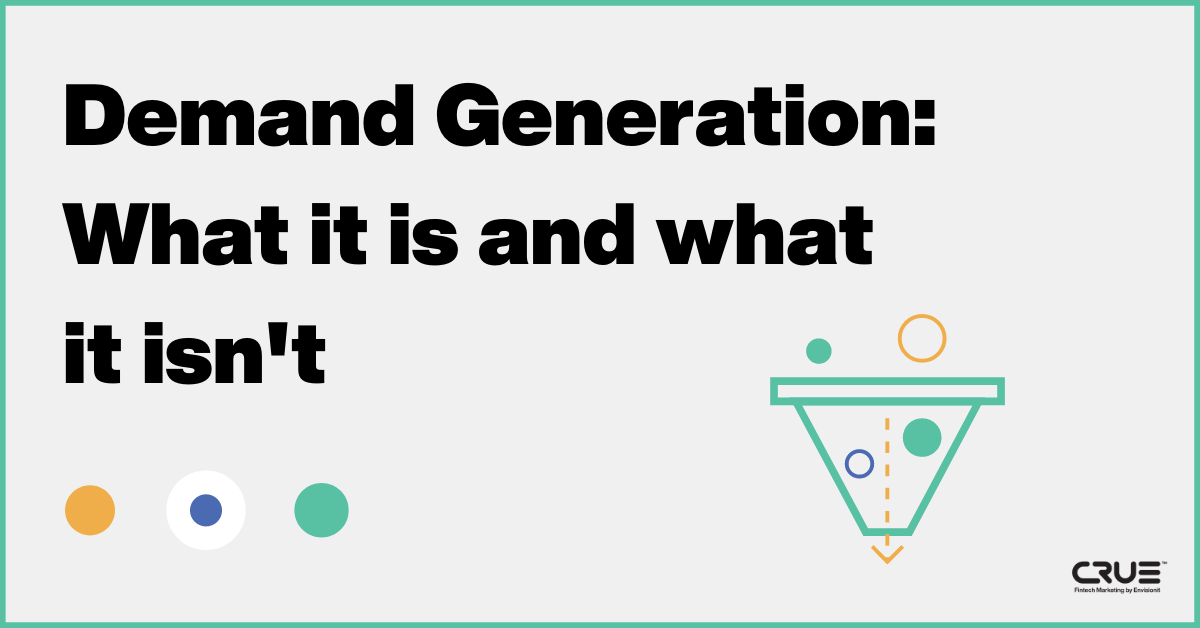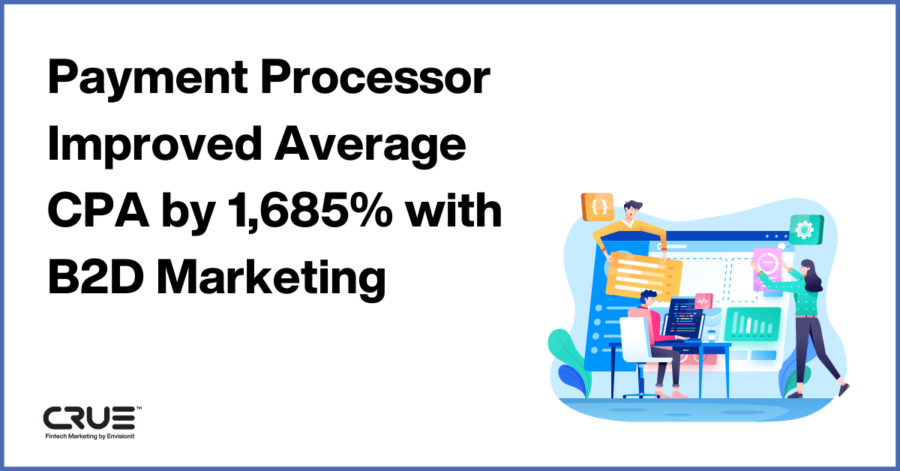Demand generation should be more than your next side project. It should be a core piece to your fintech marketing strategy. Here’s how to nail your approach.
Over the past decade working in digital marketing, nothing has intrigued me more than the concept of demand generation. Admittedly, when I first heard the phrase back in the day, it felt a little contrived. Isn’t this what marketers do? Create demand. As I continued to serve the B2B space, and particularly emerging technology, I began to realize that while we are in the business of generating demand, how we define demand generation and how it is executed is at the core of an organization’s marketing strategy…not just a side project.
When I look back, I think my initial reluctance to evangelize demand generation as a concept was rooted in my own need to understand what demand generation meant to me as a marketer. If I couldn’t truly buy into it, how could I expect my clients to? So, this became my mission. To solidify my understanding of what demand generation is and evolve my approach to help organizations of all sizes and stages reach their growth potential.
It’s not awareness, it’s demand generation.
For me to truly identify what demand generation was, it was actually most helpful for me to identify what it wasn’t. And of course, this continues to evolve over time. Throughout my career, I would often hear the word “awareness” bandied about in conversations dealing with marketing strategy. Transparently, over time it made me a little cringey because I felt it oversimplified what we do. More importantly, it oversimplified the journey of a prospective audience.
So I consulted a few of sources for definitions of “awareness” and a few stood out to me:
- knowledge or perception of a situation or fact
- the quality or state of being aware
- concern about and well-informed interest in a particular situation or development
While the last definition indicates a level of interest, the first two definitions simply point to a knowledge of something. From a marketing perspective, we can make our audience aware of a brand’s product or solution, but that doesn’t mean they’re going to take the action we’re looking for. The more complex the product or solution, the more its value needs to be explained.
As marketers, I think we often take quite a few liberties when it comes to our audience’s overall knowledge level, and even if they’re subject matter experts, they are, more importantly, decision makers or influencers. They’re also human beings with very distinct motivations and pain points that guide their decision making process.
So let’s get into what demand generation is not. Admittedly, the following observations are based on my own experiences across clients at various stages of growth. What’s worked, what hasn’t, and certain misperceptions I’ve encountered along the way.
With that said, in my opinion, demand generation is not:
1. Creating “visibility and awareness”
Rather, it’s just a part of it. If we just stopped here, we’d be spending money on placements and reporting on vanity metrics that are really hard to justify both short and long-term. A robust demand generation program considers a prospect’s existing level of awareness and creates a strategy that connects them to a brand’s underlying value proposition across multiple touch points, over a carefully considered journey.
2. Lead generation
I’m a firm believer in moving fast, and that includes launching campaigns that are meant to attract bottom funnel leads that are either very brand aware or are already in-market. Those active hand-raisers, as they’re sometimes referred to. However, the idea that a demand generation program in itself will be a major source of leads will shortcut your efforts, which will ultimately lead to the perception of poor performance.
Instead, it is meant to feed lead generation efforts and there’s heavy lifting involved. Very often, the companies I work with in fintech and emerging tech are entering uncharted territory and their prospects may not even be aware that their product or solution exists. The idea that leads will simply materialize through upper funnel touch points is simply wishful thinking at best.
3. Lead nurturing
If demand generation is not lead generation, it is certainly not lead nurturing. While an incredibly important part of the whole equation, lead nurturing is a separate effort that requires close alignment between Marketing and Sales and clear, strategic documentation of how leads are handled from initial form submission to closed/won/install, carefully considering the source and content format that delivered the lead. For example, did they simply sign up for a webinar, or did they actually convert off a retargeting ad because they’ve already been exposed to your messaging? How these leads are funneled and the subsequent lead nurturing they receive should be mapped out.
4. Fully owned by a brand
More than ever before, there are countless ways your prospects can consume information about you and that includes countless sources. The idea that you can be the sole gatekeeper of information and control the narrative of your brand or solutions is not only extremely difficult but also inefficient. Much like the decentralization that’s occurring in the financial world, the same can be said about how information is made available to prospects.
With the rise of demand generation, marketers are now uniquely challenged to pinpoint where their prospects are consuming this information (beyond owned properties), when they’re consuming this information, and the specific use cases channels serve in the decision making process. This means going outside of your walls and developing partnerships with sources whose content your target is already consuming.
5. Turnkey marketing
If demand generation was a turnkey approach to marketing, brands would be doing a lot more of it. It is undeniably hard work, but when deployed thoughtfully, strategically, and rooted in data it means the difference between incremental or flat growth and exponential growth that is transformational for a business.
Charting your organization’s path to demand generation.
In future posts, I’ll delve more deeply into the mechanics of developing demand generation programs. In the meantime, I would be remiss if I didn’t address the challenges marketers face when selling through the value of demand generation to begin with.
If there’s one thing I’ve learned working with clients in fintech and emerging tech it’s this: The company’s age, size, evaluation, or even the size of its marketing team is not directly correlated to how advanced their marketing efforts are. This is often the case when operating within a traditionally sales-led organization, where marketing (for various reasons) represents a smaller portion of budget, prioritization, and a lack of collective buy-in. Marketers evangelizing demand generation are very often confronted with the fact that our approaches don’t always appear to work at the pace of stakeholders’ goals.
So how do you show the value of what you’re trying to accomplish, create buy-in, and get your best laid plans into the market? Here are a few approaches I’ve adopted over the years that have had tangible results, not only with the sell-through of demand generation programs, but ultimately with the performance we’ve been able to achieve.
Win over Sales.
One of the hardest parts of selling through demand generation is moving beyond the need for instant gratification. If you can get the team (particularly Sales and the C-suite) to truly understand how these programs enable sales in the short-term, your conversations will be much more productive.
Laser focus on the benefits such as:
- More time spent with highly qualified leads
- Shortened sales cycles through pre-education
- More content to facilitate sales conversations and ultimately, improve close rates
- Greater lifetime value and retention
Demand generation, when carefully planned, simplifies the sale. How do you win over a sales team? By making their lives easier through your marketing efforts. Complementing their role versus working independently. The lead generation side will continue to grow as you build on the demand you’re going to create. If you’re able to help them rethink how they perceive your work and engage with marketing, the two entities can blend together nicely.
Own your audience better than anyone
The best way to sell through your strategy is to show stakeholders (especially on the sales-side) that your strategy will not only peak interest but also facilitate quicker sell-through. To do that, you need to live and breathe your audience and show your counterparts that you not only understand prospects’ motivations and pain points at the same level they do from a sales perspective, but you’ll also raise that and adapt to how they behave in a digital environment to push them along in their journey, and warm them up along the way.
Be bold and specific about what to expect
If you’re going to sell through the value of demand generation and secure the investment, make a statement of what you believe can be true. At Envisionit, we begin our engagements with a proforma for media that is based on organizational goals and how our specific marketing efforts will ladder up to and support those goals. This includes all identified channels, budgets, and both front and backend delivery metrics that are agreed upon by key stakeholders. Using first and third party data available, you can arrive at benchmarks that will serve as a scorecard for performance based on the metrics that truly matter.
You can also work in your own hypothesis of how the upper funnel will impact bottom funnel performance. For example, with one of my early fintech clients, we were able to see a 30% reduction in Paid Search cost per acquisition based on the demand we were able to create for the brand. Oftentimes, the more “tried and true” channels like Paid Search have already proven out value and met the need for instant gratification. Yet, if you can demonstrate how demand generation could further elevate these existing performance drivers, this can create a marked shift in the conversation about the value of this approach.
Always fail forward
The best marketers I’ve met don’t always get it right immediately, but are constantly trying new ideas that lead to the best outcome. In this sense, they purposely and deliberately use failures to find success. With demand generation, not everything you put into the market will work. Whether that means the messaging you put out there, the content, targeting tactics, or specific channels. Demand generation is a longer haul, and during that journey you’ll find what you’re going to keep traveling with and what tactics you’re going to be picking up or dropping off along the way.
Wrap up
For any demand generation program to be successful, your fintech organization needs to accept the basic concept that you will first see immediate impact with qualitative results, but will begin to see more tangible and quantitative results over a specific period of time. If you’re not working towards a connected vision of performance among all stakeholders, you’ll risk hitting a point of diminishing returns for your current marketing efforts. To avoid missing out on the opportunity to drive exponential growth and return on marketing, follow the demand gen guidelines here to get started, and continue to experiment and adapt to lock in your most effective fintech marketing strategy.











